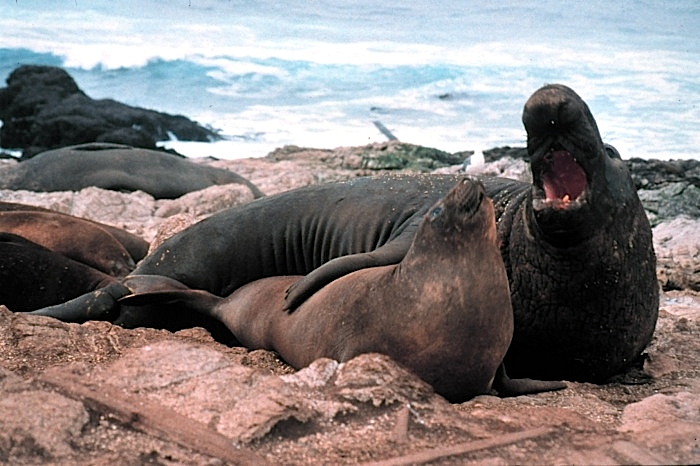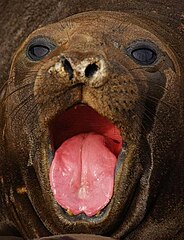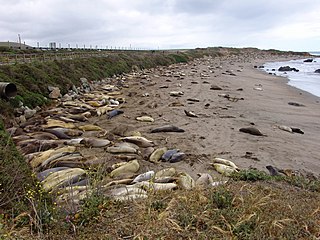The northern elephant seal, somewhat smaller than its southern relative, ranges over the Pacific coast of the U.S., Canada and Mexico. The most northerly breeding location on the Pacific Coast is at Race Rocks, at the southern tip of Vancouver Island in the Strait of Juan de Fuca. The southern elephant seal is found in the Southern Hemisphere on islands such as South Georgia and Macquarie Island, and on the coasts of New Zealand, South Africa, and Argentina in the Peninsula Valdés, which is the fourth-largest elephant seal colony in the world. In southern Chile, there is a small colony of 120 animals at Jackson Bay, Admiralty Sound (Seno Almirantazgo), Tierra del Fuego.[1] The oldest known unambiguous elephant seal fossils are fragmentary fossils of an unnamed member of the tribe Miroungini described from the late Pliocene Petane Formation of New Zealand.[2] Teeth originally identified as representing an unnamed species of Mirounga have been found in South Africa, and dated to the Miocene epoch;[3][4] however Boessenecker & Churchill (2016) considered these teeth to be almost certainly misidentified odontocete teeth.[2]
Elephant seals breed annually and are seemingly faithful to colonies that have established breeding areas.[5]
Description
Physiology

Elephant seals spend upwards of 80% of their lives in the ocean. They can hold their breath for more than 100 minutes[10][11] – longer than any other noncetacean mammal. Elephant seals dive to 1,550 m beneath the ocean's surface[10] (the deepest recorded dive of an elephant seal is 2,388 m (7,835 ft) by a southern elephant seal).[12] The average depth of their dives is about 300 to 600 m (980 to 1,970 ft), typically for around 20 minutes for females and 60 minutes for males, as they search for their favorite foods, which are skates, rays, squid, octopuses, eels, small sharks and large fish. Their stomachs also often contain gastroliths. While excellent swimmers, they are also capable of rapid movement on land.
Male elephant seals fighting for mates.
Elephant seals have a very large volume of blood, allowing them to hold a large amount of oxygen for use when diving. They have large sinuses in their abdomens to hold blood and can also store oxygen in their muscles with increased myoglobin concentrations in muscle. In addition, they have a larger proportion of oxygen-carrying red blood cells. These adaptations allow elephant seals to dive to such depths and remain underwater for up to two hours.[13]
Milk produced by elephant seals is remarkably high in milkfat compared to other mammals. After an initially lower state, it rises to over 50% milkfat (human breast milk is about 4% milkfat, and cow milk is about 3.5% milkfat).[14]
Lifespan

Northern female elephant seals have lived for 22 years, and can give birth starting at the age of three to four. Males reach maturity at five to six years, but generally do not achieve alpha status until the age of eight, with the prime breeding years being between ages 9 and 12. The longest life expectancy of a male northern elephant seal is approximately 14 years.
Status

The IUCN lists both species of elephant seal as being of least concern, although they are still threatened by entanglement in marine debris, fishery interactions, and boat collisions. Though a complete population count of elephant seals is not possible because all age classes are not ashore at the same time, the most recent estimate of the California breeding stock was approximately 124,000 individuals. In the United States, the elephant seal, like all marine mammals, is protected under the Marine Mammal Protection Act (MMPA), passed in 1972, which outlaws hunting, killing, capture, and harassment of the animal.[15]
Gallery
-
Elephant seals (Mirounga angustirostris) on Piedras Blancas beach, near San Simeon, California
-
Northern elephant seals during molting season at Piedras Blancas beach, near San Simeon, California
-
Elephant seal snout
-
Beachmasters, the dominant bulls fighting at Macquarie Island
-
Elephant seals at Piedras Blancas, California












No comments:
Post a Comment
Note: Only a member of this blog may post a comment.